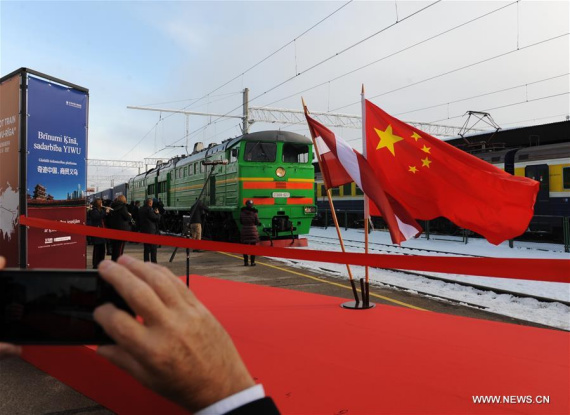
The freight train from Yiwu of China to Riga enters the Central Station of Riga, Latvia, Nov. 5, 2016. (Photo: Xinhua/Wang Yaxiong)
After a journey of 17 days covering more than 10,000 km, a freight train packed with small commodities produced in China finally arrived at its destination in Latvia's capital Riga.[Special coverage]
"Riga is the destination of the train, but not of these commodities. After the arrival, they will be distributed to different eastern European or Scandinavian countries within one to three days," said Xiong Tao, deputy mayor of Yiwu, a Chinese manufacturing hub where the small wares, mainly decorative items and souvenirs, were made.
A ceremony was held to mark the arrival of the train, the first running from Yiwu to Riga, on Friday.
Latvia was the first in the Baltic region to launch the trans-Eurasia railway operation, which connects it with the world's second largest economy.
In fact, 40 direct rail freight routes have been established between China and Europe so far, carrying goods worth billions of dollars each year. Yiwu, as the end of six such railway lines, is the busiest city.
The routes, like the ancient Silk Road over two thousand years ago, serve as a bridge between China and countries of Central and Eastern Europe (CEE) as the world's second largest economy seeks to strengthen trade partnerships and create new growth points amid sluggish global trade.
When the train from Yiwu was greeted by local officials and businessmen in the Central Station of Riga, Chinese Premier Li Keqiang was drawing a grand blueprint for the cooperation of the two sides at a high-level meeting held miles away.
"We should actively promote free trade and facilitate investment, open markets wider to each other, deepen regional economic cooperation and oppose trade and investment protectionism to give ourselves growth impetus while contributing to the world economic recovery," Li said while addressing the Sixth China and CEE Countries Economic and Trade Forum.
The visiting premier proposed to promote trade and connectivity, step up production capacity and tourism cooperation, and explore innovative ways of financial cooperation.
"The proposals are practical and targeted, taking the two sides' comparative advantages and room to improve governmental cooperation into consideration," said Xu Mingqi, a researcher with Shanghai Academy of Social Sciences.
Chinese firms with rich experience in contract engineering can help CEE countries to enhance their infrastructure, Xu said, adding that trade facilitation measures can help boost China's exports of its industrial products and CEE countries' exports of high-quality farm produce.
Echoing Xu's remarks, Zhang Monan, an analyst of the China Center for International Economic Exchanges, also thought China and CEE countries were complementary to each other. "CEE countries, mostly emerging economies with enormous untapped potential, are thirsty for technologies in high-end equipment manufacturing that China hopes to export."
Premier Li also attended a meeting between the heads of government of China and 16 CEE countries, also known as the "16+1" summit, established in Poland about four years ago. Thanks to the summit, China-CEE cooperation has seen constant expansion.
Despite a flagging global economy, China and CEE have maintained robust growth in bilateral trade, which totaled 43 billion U.S. dollars in the first nine months, up 4 percent year on year. Two-way investment stood at 7 billion U.S. dollars, with Chinese investment in CEE soaring nearly 90 percent.
To further boost trade and strengthen economic ties, the two sides are striving to improve transport networks, including Serbia's E763 highway project and the overhaul of the Budapest-Belgrade railway, as well as other infrastructure schemes, such as a thermal power plant in Bosnia and Herzegovina.
Xu believes the infrastructure improvement will not only bolster CEE's economic ties with China but help solve trade impediments inside the region, as well as to propel the China-proposed Belt and Road Initiative.
The initiative aims to build a trade and infrastructure network connecting Asia with Europe and Africa along the ancient Silk Road routes, with CEE countries as a critical link.
The infrastructure construction will generate huge financing demand and create fresh room for financial cooperation, Zhang said.
The Industrial and Commercial Bank of China (ICBC), the country's biggest lender, announced Sunday plans to initiate a Sino-CEE fund via a newly-established subsidiary to provide financial support for industrial cooperation between China and CEE countries.
The fund will focus on investment cooperation in infrastructure, high-tech manufacturing and mass consumption industries, said Jiang Jianqing, head of the Sino-CEEF Holding Company and ICBC's former chairman, adding that the size of the fund is expected to reach 10 billion euros (around 11 billion U.S. dollars).


















































